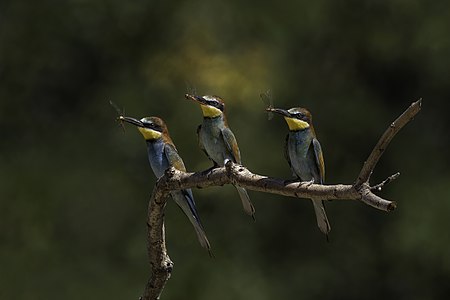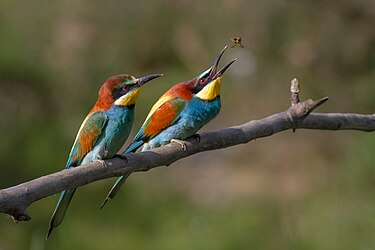Talk:European bee-eater
| This article is rated Start-class on Wikipedia's content assessment scale. It is of interest to the following WikiProjects: | ||||||||||||||
| ||||||||||||||
Untitled[edit]
To "brooded for 7 days": Which bird species could have a brooding time of less than even 10 days? Not even the smallest species! - With thanks and greetings to my (new) British collegues, Helgo BRAN 2006-07-17_16.45 CEST
Hello! This is a note to let the editors of this article know that File:Pair of Merops apiaster feeding.jpg will be appearing as picture of the day on August 25, 2014. You can view and edit the POTD blurb at Template:POTD/2014-08-25. If this article needs any attention or maintenance, it would be preferable if that could be done before its appearance on the Main Page. Thanks! — Crisco 1492 (talk) 01:02, 4 August 2014 (UTC)
Overemphasis on UK?[edit]
I can't help feeling that the article dedicates too much coverage to the rare UK breeding attempts. While it is no doubt interesting for the twitchers, it isn't really significant for the species as a whole. I'm tempted to trim the UK section to a single paragraph, but what is really needed is probably expansion elsewhere - if anyone has relevant sources, a better description of its range, along with population size etc would probably be a good start. I'll see if I can find anything myself, but others may be in a better position to locate useful sources. AndyTheGrump (talk) 10:29, 3 August 2015 (UTC)
- Hi Andy, you are obviously right. I don't know if the UK stuff would merit a stand alone article. I've good sources, just a matter of finding time... Jimfbleak - talk to me? 12:25, 3 August 2015 (UTC)
- Sorry, my post evidently wasn't clear - what I meant was expanding the rest of the article, not starting another on the UK stuff. I don't think that could be justified for a single species. It might (if there are good sources) be possible to create an article on the broader topic of rare bird sightings in the UK, though it would run the risk of becoming a long and indiscriminate list, and of filling with questionable claims. AndyTheGrump (talk) 19:22, 3 August 2015 (UTC)
- AndyTheGrump, I completely agree. I'll expand when I can, but busy in RL at present. I have access to the online version of Handbook of Birds of the World and I own Kingfishers, Bee-eaters and Rollers. If you want to make a start, email me and I'll send you what I've got Jimfbleak - talk to me? 05:30, 4 August 2015 (UTC)
Featured picture scheduled for POTD[edit]
Hello! This is to let editors know that File:European bee-eaters (Merops apiaster) with dragonflies.jpg, a featured picture used in this article, has been selected as the English Wikipedia's picture of the day (POTD) for April 2, 2024. A preview of the POTD is displayed below and can be edited at Template:POTD/2024-04-02. For the greater benefit of readers, any potential improvements or maintenance that could benefit the quality of this article should be done before its scheduled appearance on the Main Page. If you have any concerns, please place a message at Wikipedia talk:Picture of the day. Thank you! — Amakuru (talk) 12:19, 17 March 2024 (UTC)

|
|
The European bee-eater (Merops apiaster) is a bird in the bee-eater family, Meropidae. It breeds in southern and central Europe, northern and southern Africa, and western Asia. Except for the resident southern African population, the species is strongly migratory, wintering in tropical Africa. This species, like other bee-eaters, is a richly coloured, slender bird. It has brown and yellow upper parts, whilst the wings are green and the beak is black. It can reach a length of 27–29 cm (10.6–11.4 in), including the two elongated central tail feathers. The most important prey item in its diet is Hymenoptera, mostly the European honey bee. Its impact on bee populations, however, is small. It eats less than 1% of the worker bees in areas where it lives. This group of three European bee-eaters, each with a dragonfly in its mouth, was photographed in Kondor Tanya, Kecskemét, Hungary. Photograph credit: Charles J. Sharp
Recently featured:
|
Diet Composition and Effect on Bee Foraging Behaviour[edit]
Hello,
while I was reviewing the linked reference (https://dx.doi.org/10.21608/jppp.2010.86968) for the effect of bee-eater presence on bee foraging behaviour I noticed that the linked study is not generally of very high quality and the interpretation of their own data in their abstract is quite misleading. They claim that the "average meal" is 90.8% bees and 9.2% beetles, but in the paper they show that actually out of 14 birds: 12 had eaten only bees, 1 had eaten only beetles, and 1 had eaten both. Their phrasing does not reflect the actual distribution in my opinion. However, I understand that we are not to interpret the authors work - so what is to be done in this situation?
Should I find sources that I think treat the issue better? I was generally not well convinced by the data and arguments in the paper broadly. Or is this issue just a symptom of citing primary research in the first place, and the right idea would be to find a good review the covers the same issue?
Is it too much editorializing to reword it to something like "out of 14 birds killed, 12 had eaten only bees, 1 only beetles, and 1 both with the overall count of the insects composed primarily (129/142 = 90.8%) of bees"? ave mathju at ase manoya (talk) 00:22, 3 April 2024 (UTC)




